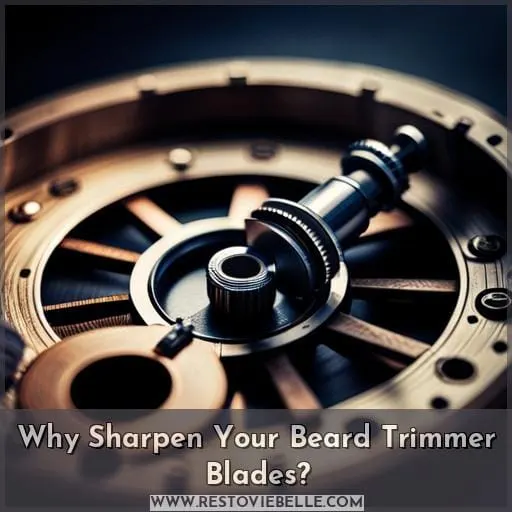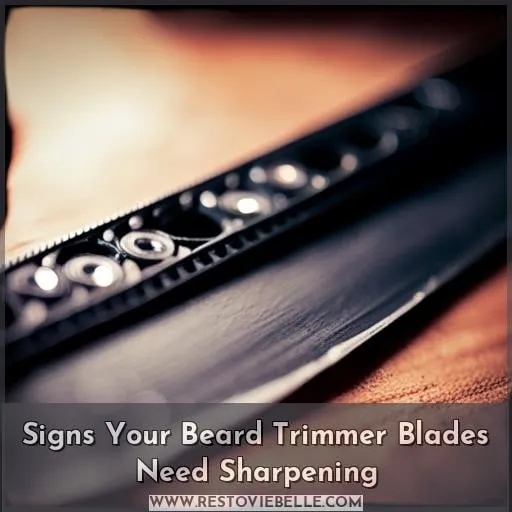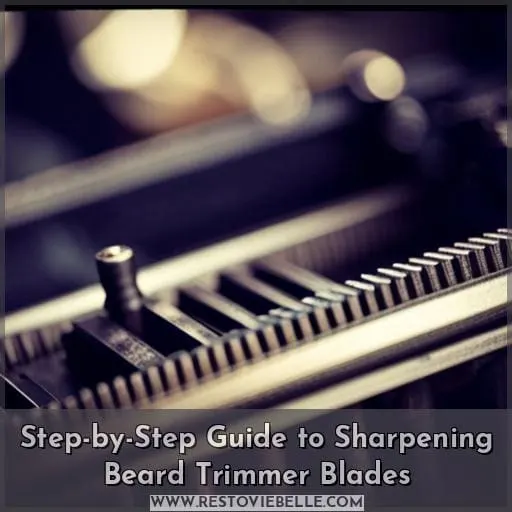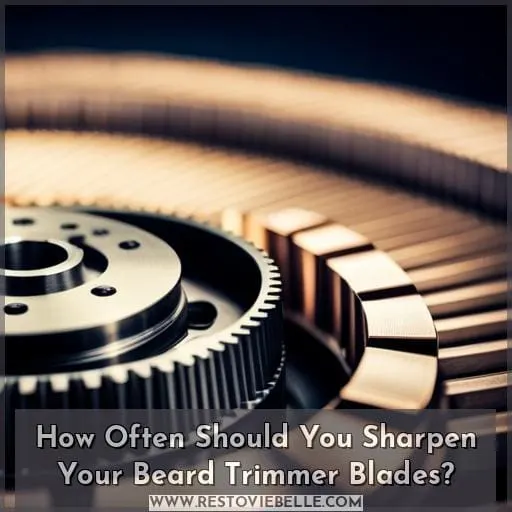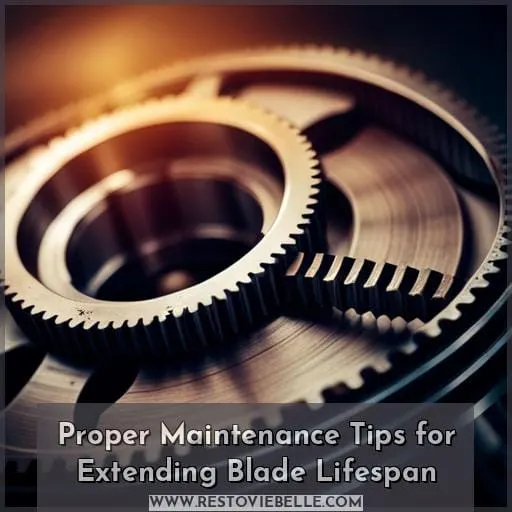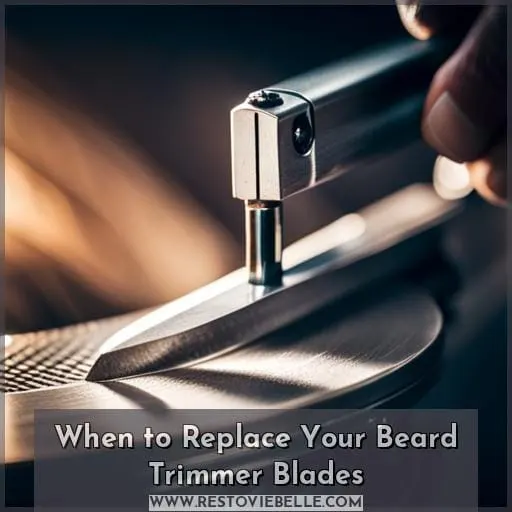This site is supported by our readers. We may earn a commission, at no cost to you, if you purchase through links.
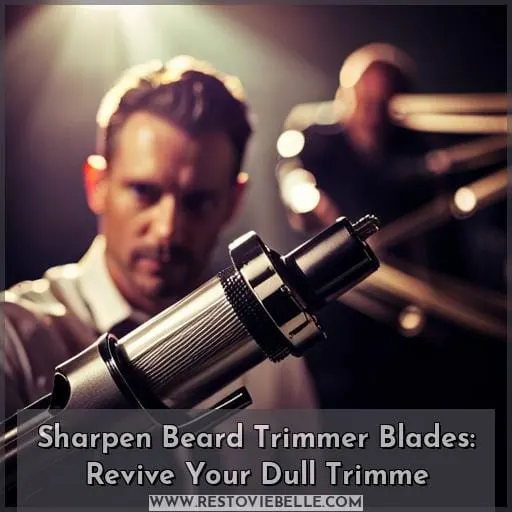 Ready to revive your dull beard trimmer and achieve a clean, precise shave? Discover how to sharpen those blades like a pro.
Ready to revive your dull beard trimmer and achieve a clean, precise shave? Discover how to sharpen those blades like a pro.
- The signs that indicate it’s time for sharpening
- Different methods to choose from
- Maintenance tips for extending blade lifespan
Say goodbye to uneven cuts and hello to a sharp trimming experience every time. Sharpening your beard trimmer has never been easier!
Table Of Contents
- Key Takeaways
- Why Sharpen Your Beard Trimmer Blades?
- Signs Your Beard Trimmer Blades Need Sharpening
- Methods for Sharpening Beard Trimmer Blades
- Step-by-Step Guide to Sharpening Beard Trimmer Blades
- How Often Should You Sharpen Your Beard Trimmer Blades?
- Proper Maintenance Tips for Extending Blade Lifespan
- When to Replace Your Beard Trimmer Blades
- Professional Sharpening Services Vs. DIY Methods
- Frequently Asked Questions (FAQs)
- What are some common mistakes to avoid when sharpening beard trimmer blades?
- Are there any alternative methods to sharpening beard trimmer blades?
- How long does it typically take to sharpen beard trimmer blades?
- Can I use the same sharpening techniques for both corded and cordless beard trimmers?
- Is it possible to sharpen damaged or chipped beard trimmer blades?
- Conclusion
Key Takeaways
- Signs of blade dullness include uneven cutting, pulling or snagging on hair, dull or jagged cuts, blade alignment issues, and loss of sharpness.
- To maintain the longevity of your beard trimmer blades, regularly clean them, lubricate them with oil, store them properly to prevent rust, evaluate their condition, and adjust sharpening frequency based on use.
- There are various methods for sharpening beard trimmer blades, such as using a sharpening stone, electric blade sharpener, or honing rod, and applying proper angles and techniques. Professional services can also be sought when necessary.
- The step-by-step process for blade sharpening includes disassembling the blades, preparing the sharpening tool, properly sharpening the blades, testing sharpness, and cleaning and reassembling the blades.
Why Sharpen Your Beard Trimmer Blades?
If you want to maintain a sharp and precise trim, it’s essential to regularly sharpen your beard trimmer blades.
Sharpening your blades not only restores their sharpness but also prolongs their longevity, ensuring optimal performance for an extended period.
DIY challenges may arise during the blade sharpening process, as it requires disassembly of the trimmer and careful handling of small parts. However, with proper knowledge and techniques, these challenges can be overcome successfully.
Additionally, regular blade maintenance is crucial in preventing rust buildup on the blades as rust can affect both sharpness and durability.
While some prefer DIY methods for sharpening their beard trimmer blades at home using various tools like stones or electric sharpeners; others may opt for professional services that offer specialized expertise in restoring blade sharpness through advanced techniques such as grinding wheels or honing rods while ensuring optimal angles are maintained throughout the process.
Signs Your Beard Trimmer Blades Need Sharpening
If you’ve noticed that your beard trimmer is giving you uneven cuts, pulling or snagging on your hair, or leaving behind dull and jagged edges, these are clear signs that your blades need sharpening.
Uneven cutting can indicate thin and uneven blade edges from over-sharpening, while pulling or snagging suggests a lack of sharpness.
Dull or jagged cuts are also a telltale sign that it’s time to sharpen your beard trimmer blades for optimal performance.
Uneven Cutting
To determine if your beard trimmer blades need sharpening, pay attention to the quality of your cuts.
If you notice uneven cutting or inconsistent results, it may be time to give those blades some much-needed attention. Uneven cutting is a clear sign that the blade alignment and sharpening angles are off.
DIY challenges can arise when attempting to correct these issues, so considering professional sharpening services is recommended for optimal results and trimmer safety.
Additionally, proper maintenance and rust prevention techniques should be implemented to prolong blade lifespan.
Pulling or Snagging
If you notice your beard trimmer pulling or snagging on your hair, it’s a clear sign that the blades need sharpening.
- Blade Dullness: Over time, blade edges become dull and struggle to cut through hair smoothly.
- Hair Buildup: Accumulated hair and debris can cause blades to pull or snag instead of cleanly cutting.
- Lack of Maintenance: Insufficient oiling and cleaning can lead to decreased sharpness.
By addressing these issues through proper blade sharpening, maintenance, and troubleshooting tips, you can prevent snags while extending the longevity of your beard trimmer blades.
Dull or Jagged Cuts
If you notice that your beard trimmer is giving you dull or jagged cuts, it’s a clear sign that your blades are in need of sharpening. Dull or damaged blades can result in inconsistent trimming and an unkempt appearance.
To avoid this, it’s important to prioritize blade maintenance and sharpening. By regularly maintaining and sharpening your trimmer blades using DIY alternatives like honing stones or electric blade sharpeners, you can extend the longevity of your blades while ensuring safe and precise grooming results.
Remember to follow safety precautions when handling sharp tools during the process for optimal results.
Methods for Sharpening Beard Trimmer Blades
Now let’s explore three effective methods for sharpening your beard trimmer blades:
- Using a sharpening stone
- Utilizing an electric blade sharpener
- Employing a honing rod
Each method has its own advantages and considerations. By understanding the steps involved in each technique, you’ll be able to choose the one that best suits your needs and brings new life to your dull trimmer blades.
Using a Sharpening Stone
To sharpen your beard trimmer blades using a sharpening stone, follow these steps:
First, disassemble the blades and clean them thoroughly.
Next, place the base of the blade in a magnetic holder or use a strong magnet as a makeshift holder.
Use a 4000 grit surface for initial sharpening at an angle of 30-45 degrees, then switch to an 8000 grit honing stone for a sharper edge.
Finally, reassemble the blades securely and regularly oil them for optimal maintenance.
Using an Electric Blade Sharpener
Now let’s explore how you can sharpen your beard trimmer blades using an electric blade sharpener. This method is quick and efficient, allowing you to restore the sharpness of your blades with ease.
Electric sharpener benefits include precision sharpening, DIY efficiency, and a quick revival of dull trimmers. By utilizing an electric blade sharpener, you can extend the longevity of your beard trimmer blades while maintaining professional-level performance.
Just remember to follow safety precautions when handling the device for optimal results.
Using a Honing Rod
You can also hone beard trimmer blades with a honing rod by:
- Removing and cleaning the blades.
- Properly positioning the trimmer at the right angle against the rod.
- Using a back-and-forth motion.
- Testing the restored sharpness and repetition on the opposite edge as well.
This realigns the edges without removing metal, so consult a professional if extensive sharpening is needed to prevent losing the blade’s natural shape over time.
Step-by-Step Guide to Sharpening Beard Trimmer Blades
When your beard trimmer blades become dull, reviving them is possible by following some key steps.
- Removing the blades
- Preparing the sharpening tool
- Sharpening the blades properly
- Testing their sharpness
- Cleaning and reassembling them
Let’s examine the process in detail now.
Removing the Blades
Once you have determined that your beard trimmer blades need sharpening, carefully unscrew and detach the blades from the trimmer housing before proceeding with the sharpening process.
- Use a small screwdriver to remove any screws securing the blades.
- Gently pry them loose.
Take care when handling the detached blades to avoid injury from their sharp edges.
Number the blades to ensure proper reassembly order later.
Preparing the Sharpening Tool
To prepare the sharpening tool for your beard trimmer blades, gather all the necessary equipment and ensure they’re clean and ready for use.
Choose a suitable DIY sharpening method based on your preference, such as using a sharpening stone, an electric blade sharpener, or a honing rod.
Check for any signs of rust on the blades before proceeding with the sharpening process.
Regular maintenance is crucial to extend blade lifespan, including oiling them regularly and keeping them clean.
Sharpening the Blades
When sharpening the blades of your beard trimmer, start by preparing the sharpening tool.
Ensure that the blades are free from rust and debris by thoroughly cleaning them with a brush or cloth.
Next, use a 4000 grit surface to initially sharpen the blades at a 30-45º angle.
Follow up with an 8000 grit stone for a finer edge.
Remember to exercise caution when handling ceramic blades as they can break easily.
For added convenience, consider professional blade sharpening services.
Testing the Sharpness
Now it’s time to test the sharpness of your beard trimmer blades. To ensure optimal cutting performance, follow these steps:
- Take a piece of paper and hold it in your hand.
- Gently run the blade across the paper, allowing it to cut through smoothly.
- Repeat this process with a piece of fabric or cardboard for different textures.
- Pay attention to any signs of dull or jagged cuts, pulling or snagging.
Cleaning and Reassembling the Blades
Once you have finished sharpening the beard trimmer blades, it’s important to clean and reassemble them properly for optimal performance.
Effective cleaning is essential for blade longevity and rust prevention.
Start by locating and unscrewing the screws at the base of the blades, then gently detach them along with any accompanying pieces.
Clean the blades thoroughly using a wire brush or toothbrush to remove hair and debris.
Once cleaned, reassemble them in their original orientation, ensuring tight screwing for optimal assembly.
How Often Should You Sharpen Your Beard Trimmer Blades?
To determine the frequency of sharpening your beard trimmer blades, it’s important to consider factors such as usage and the quality of cuts you’re achieving. The longevity of your blades depends on how often you use them and how well you maintain them.
Here are some key points to keep in mind when deciding how frequently to sharpen your beard trimmer blades:
- Evaluate the quality of your cuts: If you notice that your trims are becoming uneven or jagged, it could be a sign that it’s time for a sharpening session.
- Consider prolonged use: Regular and prolonged use can cause blade dullness over time. It may be necessary to sharpen more frequently if you use your trimmer extensively.
- Inspect the condition of the edges: Take a close look at the blade edges for signs of wear or damage. If they appear chipped or worn out, it’s likely time for maintenance.
Remember that regular maintenance includes cleaning and oiling after every few uses, which helps prolong blade sharpness between sharpenings.
Proper Maintenance Tips for Extending Blade Lifespan
To extend the lifespan of your beard trimmer blades, proper maintenance is key.
- Cleaning the blades regularly is essential to remove hair and debris that can affect their performance.
- Applying oil to the blades helps reduce friction and prevent wear,
- While storing the trimmer properly in a dry location prevents rusting and extends blade life.
Cleaning the Blades Regularly
To properly maintain the lifespan of your beard trimmer blades, it’s essential to clean them regularly.
Efficient cleaning not only ensures optimal performance but also extends blade longevity.
Start by inspecting the blades for any hair or debris buildup and remove it using a brush or toothbrush.
Wipe down the blades with a towel and consider using trimmer spray for disinfection.
Regularly cleaning your blades will help prevent rust, ensure proper blade usage, and troubleshoot potential issues before they become major problems in maintaining sharpness.
Applying Oil to the Blades
To properly maintain your beard trimmer blades and extend their lifespan, it’s important to regularly apply oil to the blades.
Blade lubrication plays a crucial role in preventing rust and ensuring optimal performance. By applying a few drops of hair clipper oil after each use or every two to three uses, you can reduce friction, prevent blade wear, and enhance overall blade longevity.
Make sure to inspect the blades regularly for any signs of damage or dullness that may require sharpening.
Proper Storage of the Trimmer
To maintain the sharpness and longevity of your beard trimmer blades, it’s essential to store the trimmer properly.
Safe storage is crucial for preventing moisture buildup, which can lead to rust and damage.
Make sure to inspect the blades regularly for any signs of wear or damage before storing them.
Store your trimmer in a dry place away from moisture, ideally in a protective case or pouch to provide additional blade protection.
Proper storage will help extend the lifespan of your trimmer’s blades and ensure optimal performance when you need it most.
When to Replace Your Beard Trimmer Blades
If your beard trimmer blades are consistently dull even after sharpening, it may be time for you to consider replacing them. Blade longevity depends on various factors such as material durability and maintenance frequency.
- Excessive Wear: If you notice significant damage or chipping on the blade edges, it’s a clear indication that they’ve worn out and need replacement.
- Ineffective Cutting: If your blades struggle to cut through hair smoothly or leave behind uneven cuts despite sharpening, this suggests that they’ve lost their sharpness and should be replaced.
- Rust Buildup: Rust not only affects the performance of the blades but also poses a safety risk during use. If rust is present even after cleaning and oiling the blades, it’s best to opt for blade replacements.
By being mindful of these indicators and regularly maintaining your trimmer with proper cleaning and oiling techniques, you can ensure optimal performance while preventing rust buildup for long-lasting use before considering blade replacements.
Professional Sharpening Services Vs. DIY Methods
Now that you have learned about when to replace your beard trimmer blades, let’s discuss the options available for sharpening them.
When it comes to sharpening your trimmer blades, you can either opt for professional sharpening services or try DIY methods.
In order to help you make an informed decision, here is a comparison table highlighting the key factors related to professional sharpening services and DIY methods:
| Factors | Professional Sharpening Services | DIY Methods |
|---|---|---|
| Cost Analysis | Can be more expensive | More cost-effective |
| Skill Development | No skill required | Opportunity for skill development |
| Quality Control | Consistent results Variable results |
Time Efficiency Fast turnaround time Time-consuming
Equipment Comparison High-quality equipment Simple tools needed
Professional sharpeners offer convenience and expertise in blade maintenance. They use specialized equipment that ensures precise results. However, they may come at a higher cost compared to the do-it-yourself approach.
On the other hand, opting for DIY methods allows you to save money while providing an opportunity for skill development as well as control over quality assurance.
Ultimately, choosing between professional sharpening services and DIY methods depends on your individual needs and preferences.
Frequently Asked Questions (FAQs)
What are some common mistakes to avoid when sharpening beard trimmer blades?
To avoid common mistakes when sharpening beard trimmer blades, be careful:
- Not to over-sharpen and thin out the blade edges.
- To properly store your trimmers.
- To regularly clean them with a brush and disinfectant spray.
Are there any alternative methods to sharpening beard trimmer blades?
Yes, some alternative methods exist.
Carefully consider using a whetstone, bench grinder, or professional sharpening service.
Research proper techniques beforehand. Improper methods risk permanent blade damage.
Seek guidance if unsure.
Prioritize safety.
How long does it typically take to sharpen beard trimmer blades?
Sharpening beard trimmer blades typically takes around 10-15 minutes, depending on the method used and the condition of the blades. With proper technique, you can achieve sharpness for optimal trimming and grooming results.
Can I use the same sharpening techniques for both corded and cordless beard trimmers?
Absolutely not. Corded and cordless beard trimmers have completely different mechanisms, requiring distinct sharpening techniques.
Is it possible to sharpen damaged or chipped beard trimmer blades?
Yes, it’s possible to sharpen damaged or chipped beard trimmer blades.
Using appropriate tools such as a honing stone or electric sharpener, you can restore the sharpness and functionality of your blades for optimal trimming performance.
Conclusion
To achieve a clean and precise shave, it’s important to sharpen your beard trimmer blades regularly.
- Uneven cutting
- Pulling or snagging
- Dull or jagged cuts
There are different methods you can choose from, such as:
- Using a sharpening stone
- Using an electric blade sharpener
- Using a honing rod
By following our step-by-step guide, you can easily sharpen your blades and extend their lifespan.
[Keypoints]Remember to maintain your trimmer by:
- Cleaning the blades regularly
- Applying oil
- Storing it properly
Say goodbye to a dull trimmer and hello to a sharp trimming experience every time.
